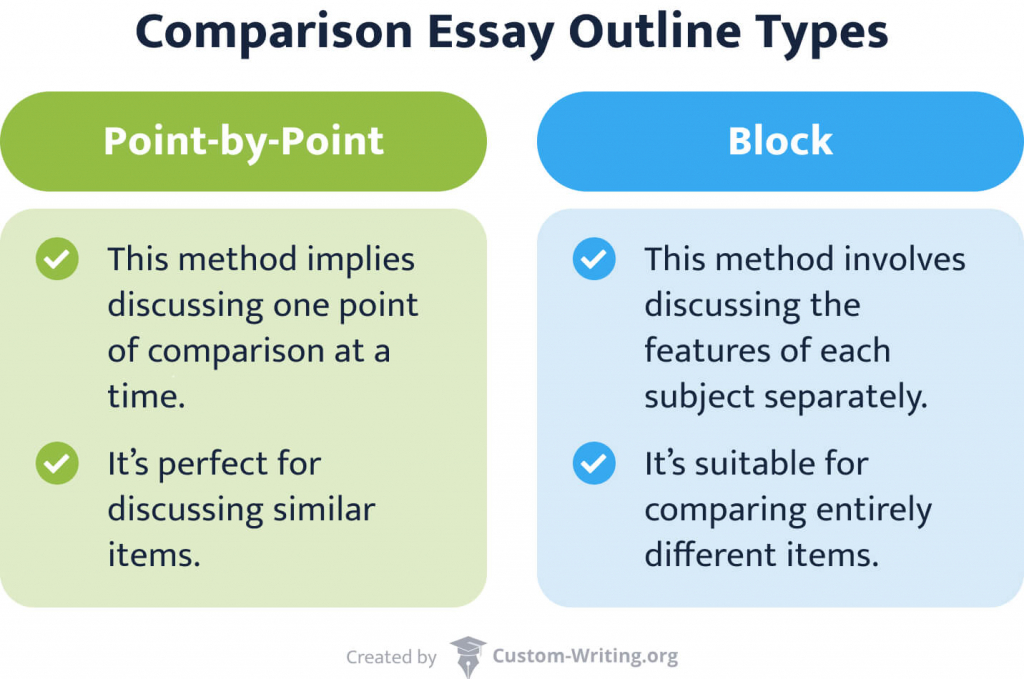High school and college students often face challenges when crafting a compare-and-contrast essay. A well-written paper of this kind needs to be structured appropriately to earn you good grades. Knowing how to organize your ideas allows you to present your ideas in a coherent and logical manner

This article by our custom-writing team delves into all the fine details of structuring your compare-and-contrast paper. It also provides practical examples of the two main outlining methods you may use. Keep reading to up your writing game!
👀 Compare and Contrast Essay Outline Types
A compare and contrast paper studies similarities and differences between two or more subjects. But how do you present the points of comparison? Well, in this kind of essay, there are two methods of structuring the text: point-by-point and block.
Before composing your essay, it’s crucial to choose the approach that suits your assignment best. Your choice will depend on how you want to approach and present your ideas.
Let’s examine these two methods in more detail.
Point-by-Point Comparison Essay
The point-by-point method implies discussing one point of comparison at a time. For example, if you’re comparing two cities, you may dedicate separate paragraphs to their size, population, and architecture.
The point-by-point arrangement has advantages and disadvantages. Keep them in mind before deciding whether to use it or not.

Block Method Compare and Contrast Essay
The block method, also known as subject-by-subject comparison, is a way of outlining your assignment that involves discussing each subject separately. For example, in an essay about different types of fruit, you will discuss the features of one fruit at a time.
This approach has shortcomings and strengths that may affect how you want to handle your essay.
🔍 Comparative Essay Outline: Before You Start
After you’ve chosen a topic (you’re welcome to consult our list of compare-and contrast essay topics for inspiration,) you enter the pre-writing stage. It involves brainstorming, researching, and determining which points are the most important. Here’s how to do it:
- Brainstorming and in-depth research are vital when working on a compare-and-contrast essay. It helps you figure out the direction your paper will take and provides you with source materials. At this initial stage, your main goal is to identify various similarities and differences between the things you want to write about.
- After determining the similarities and differences between your subjects of choice, decide which points are the most significant. They will assist you in developing your essay’s thesis statement and paragraphs.
It’s important to remember that you can leave some things out of your assignment. There may be so much material to cover that you will never finish the paper in the first place!
So, how do you determine what’s worth including in your paper? Consider the following factors:
Useful Tip:
You can draw a Venn diagram and list the similarities and differences to make your comparison easier. Simply draw large intersecting circles and name each one to reflect the traits or subjects you are comparing. Write all the similarities inside the circles’ intersections and differences in the remaining space of each one.
Here’s an example of a Venn diagram comparing the US and Canada with crosses and checkmarks representing what’s different and similar between them, respectively:

✍️ How to Write a Compare and Contrast Essay Outline
Do you need some more guidance in outlining your paper? Well, look no further! Here is a comprehensive coverage of how to write a perfect outline for your compare-and-contrast essay.
Compare and Contrast Essay Introduction
Your essay’s introduction is arguably its most important section. It gives readers a solid summary of your paper’s contents and helps them understand what to expect as your comparison essay progresses.
Here’s what a good introduction is made of:
- Background information about your topic that the readers need to know before proceeding.
- A catchy hook that captures and retains your audience’s attention up to the end.
- A thesis statement that provides a direction and ties up your whole assignment. All your arguments will focus on defending this statement.
Hook for Compare and Contrast Essay + Example
Ways of creating a hook can differ based on your essay’s purpose and overall tone:
Here is a hook example to inspire you. It uses statistics in the form of a question:
Example:
Did you know that over 60% of online shoppers prefer using their mobile devices over desktop ones?
Need more ideas on how to start your essay? Check out our article on hooks in writing!
How to Write a Compare and Contrast Thesis
Formulating your paper’s thesis statement is critical to drafting the outline. In most cases, its purpose is to clarify what features make the subjects of comparison different or similar.
Note that your essay’s thesis may vary depending on its function. For instance, it might serve an informational or judgmental purpose:
- If your thesis is informative, you only need to enumerate differences and similarities between your subjects of comparison.
- But if your thesis is judgmental, you should state which similarities or differences are the most significant.
Check out these examples to understand the difference better:
Comparison Essay Outline: Body Paragraphs
Body paragraphs in a contrast essay support your thesis about the subjects you are comparing.
Each body paragraph should start with a topic sentence that states the passage’s main idea. The rest depends on the type of outline you’re using: you either discuss the features of one subject of comparison or focus on one criterion and describe it in relation to each topic.
Let’s see it in more detail. Say, we’re comparing subjects A and B according to their features 1, 2, and 3:
📌 Point-by-Point Body Paragraphs Arrangement
📌 Block Method Body Paragraphs Arrangement
Compare and Contrast Essay Transition Words
A compare and contrast essay features a set of similar and distinct items. To make the comparison easier to understand, you can use words that create a smooth transition between your ideas and thoughts.
Transition words serve 4 essential purposes in a compare and contrast assignment:
- They make transitioning and linking between thoughts easier.
- They make your writing more dynamic.
- They improve readability in your paper.
- They set the stage for ideas that will be introduced next.
Here are transition words you can use to show similarities in your comparison essay:
Example:
Similarly, too, just as, also, both, comparatively, same as, like, in the same way.
For contrasting, use appropriate transition words to give your paper a more logical, coherent flow. These include:
Example:
However, in contrast to, conversely, while, more than/less than, rather than, unlike, although, compared with.
Compare and Contrast Essay Conclusion
Finally, it’s time to wrap up your comparison essay. Your conclusion should contain 2 core elements:
- Summarized key points.
Sum up the main arguments you’ve presented throughout your essay. Make sure to refrain from introducing any new ideas at this point! - A restated thesis.
Your essay’s conclusion should also restate your thesis and prove that you’ve effectively defended it in the body paragraphs. - A final thought.
A good conclusion leaves the reader with something to think about. In a compare-and-contrast essay, it can be a statement that connects it to the broader context or underlines the topic’s significance.
✅ Compare and Contrast Essay Outline Template
Now, let’s sum up everything you’ve learned about different ways to outline your compare-and-contrast essay using the block or point-by-point approaches. Here are the templates you can use for structuring your paper:
📌 Point-by-Point Method Outline Template
📌 Block Method Outline Template
📑 Compare and Contrast Outline Examples
Are you stuck with your paper and need an outline example to inspire you? You’ll find it below!
Here are 2 outline samples done using point-by-point and block methods.
📌 Point by Point Outline Example: Differences between Fresh and Canned Foods
📌 Block Method Outline Example: Differences between Backpacking and Staying in Hotels
We hope these insights and template examples will inspire you to master the structure of the compare-and-contrast essays. Use these ideas to excel in your studies and do your homework quickly!
Further reading:
- Compare and Contrast Essay Writing Tips and Examples
- Literature Review Outline: Examples, Approaches, & Templates
- Rhetorical Analysis Essay Outline: Examples & Strategies
- How to Write a Narrative Essay Outline: Template & Examples
🔗 References
- Comparison and Contrast: University of Minnesota
- Comparing and Contrasting: University of North Carolina at Chapel Hill
- How to Write a Compare-and-Contrast Essay: Grammarly
- Writing for Success: Compare/Contrast: Kellogg Community College
- Compare & Contrast Essay: Excelsior University Site
- Comparison and Contrast Essays: Saint Mary’s University
- Compare & Contrast Assignments: The University of Arizona Global Campus
- Organizational Patterns for the Comparison/Contrast Essay: San José State University
- Compare/Contrast Papers: University of Washington

![Precis Example, Definition, & Writing Guide [2025]](https://custom-writing.org/blog/wp-content/uploads/2022/02/education-concept-student-studying-brainstorming-campus-concept-close-up-students-discussing-their-subject-books-textbooks-selective-focus-284x153.jpg)

![Critical Analysis Essay Example & Writing Guide [2025]](https://custom-writing.org/blog/wp-content/uploads/2021/10/business-men-sitting-lawyers-s-desk-people-signing-important-documents-284x153.jpg)







![How to Write an Argumentative Essay: 101 Guide [+ Examples]](https://custom-writing.org/blog/wp-content/uploads/2021/01/young-writer-taking-notes-284x153.jpg)